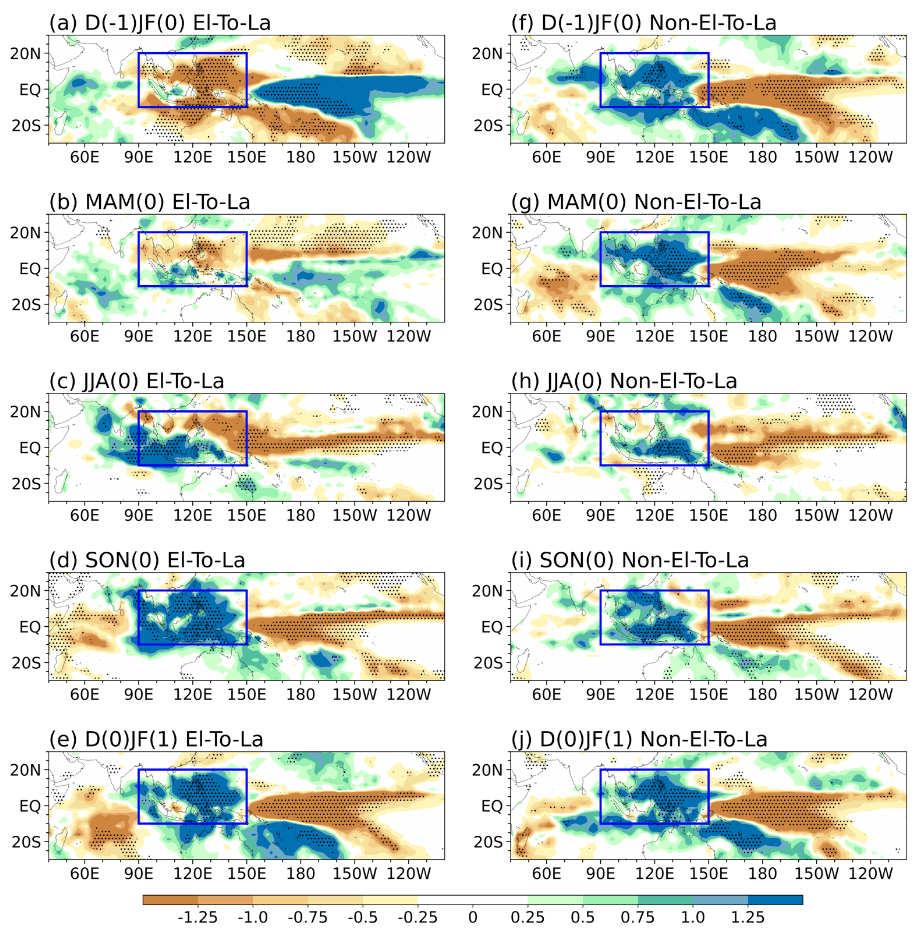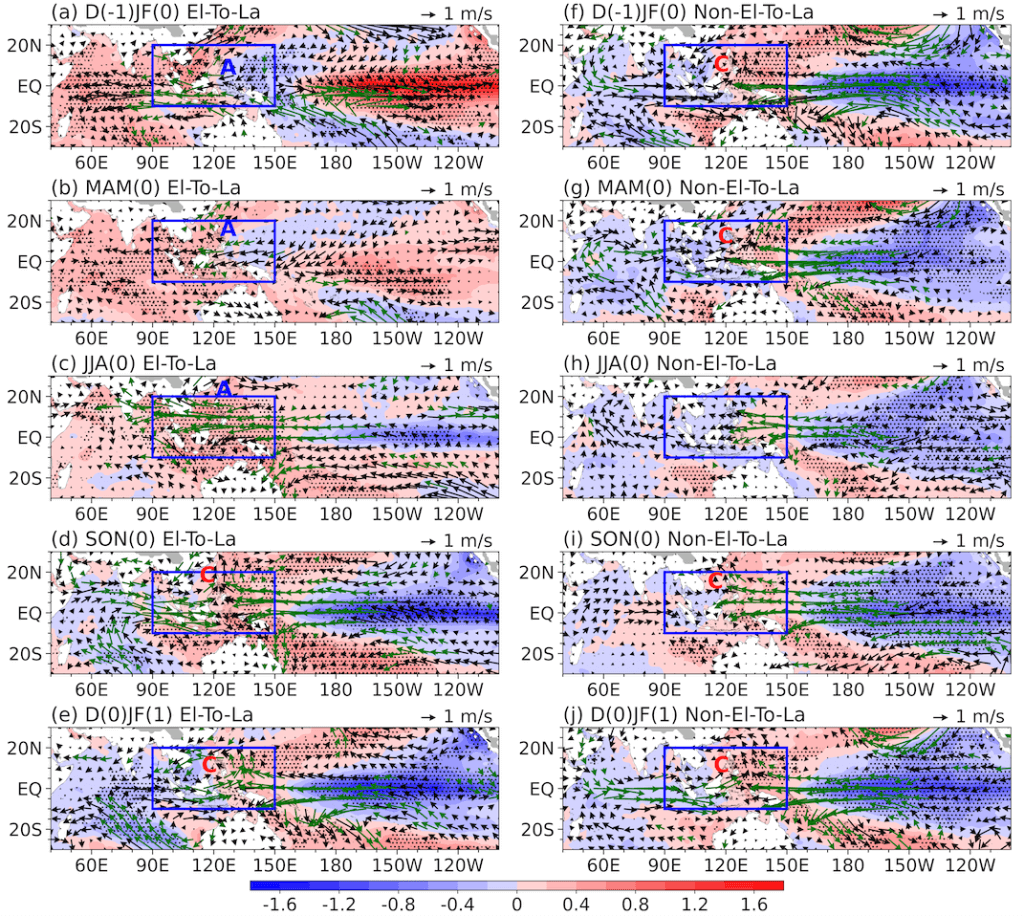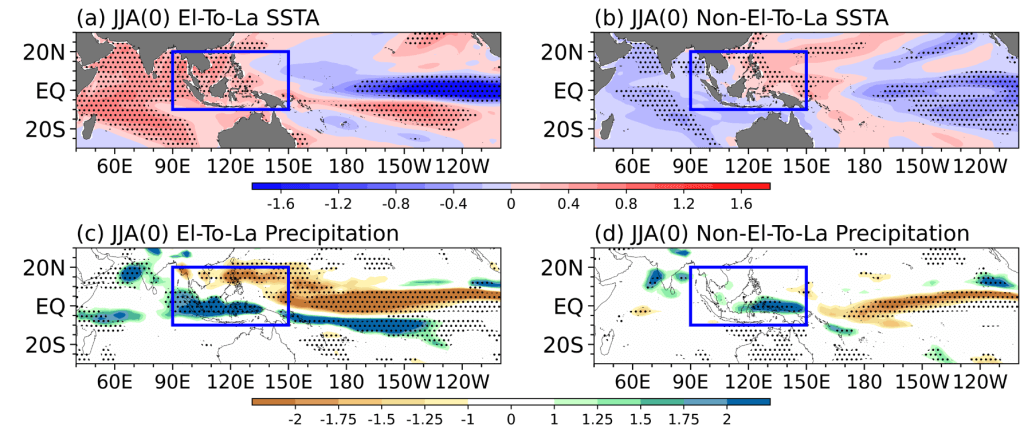
Impact of different types of La Niña development on the precipitation in the Maritime Continent
– By Shanshan Zhong, Yuzhi Zhang, and Leishan Jiang –
Research motivation
The Maritime Continent (MC), located in the tropical region (10°S-20°N, 90°E- 150°E) , is the largest center of the equatorial atmospheric convective activity in the world. The condensational latent heat released by precipitation in the MC provides enormous energy for global atmospheric circulations. Therefore, the precipitation anomalies in the MC have a profound impact on the global weather and climate change.
The variation of precipitation in the MC is largely influenced by the El Niño-Southern Oscillation (ENSO). The ENSO signal could induce anomalous zonal wind and SST in the MC via altering the SST gradient from the MC to the tropical eastern Pacific, which can further modulate the Walker circulation and lead to anomalous precipitation in the MC.
Previous studies have shown that the La Niña, that is, the enhancement of cold SST over the central and eastern tropical Pacific (CETP), is favorable to enhanced precipitation in the MC. However, few studies have revealed the differences in the impact of diversity in the early stages of La Niña on precipitation in the MC. Actually, the evolution process of La Niña events shows diversity. Some La Niña events are transitioned from El Niño events and some are not, although they eventually exhibit cold SST anomalies in the CETP. Then, what are the main types of the evolution of La Niña events? Are there any differences in the impact of the diversity of La Niña development on precipitation in the MC? These scientific questions are still unclear and will be explored in the paper.

Conclusion

The development processes of La Niña events primarily manifest in two types (Fig.1). One is El-To-La (red line), originating from the transition of El Niño in the preceding winter, and the other is Non-El-To-La (blue line), evolving from a non-El Niño state in the previous winter.
Figure 2 shows the precipitation anomalies in the MC of these two types of La Niña from the preceding winter to the current winter. From the preceding winter to spring, due to the contrasting SST in the CETP, the precipitation anomalies in the MC region are opposite for two types of La Niña development (Fig. 2a, b, f, g). When there is positive (negative) abnormal precipitation over the CETP, the MC region is mostly negative (positive) abnormal precipitation, which is consistent with previous studies. In boreal summer, the Niño3.4 indices turn negative, with similar intensity, for both types of La Niña (Fig. 1). However, the summer precipitation anomalies in the MC differ between these two types (Fig. 2c, h), with positive precipitation anomalies covering the southern MC region, centered in the southwestern MC for the El-To-La type (Fig. 2c), while only confined to the southeastern MC region for the Non-El-To-La type (Fig. 2h).

In boreal summer, for the El-To-La type, the local SST anomalies are positive in the entire MC region (Fig. 3c), which sets up a strong SST gradient between the warm MC and the cold CETP. The anomalous zonal Walker circulation associated with the zonal SST gradient causes uniform ascending anomalies over the MC region, promoting widespread positive precipitation. The local uniform warm SST anomalies also contribute to positive specific humidity, further enhancing the precipitation anomaly. Therefore, positive precipitation anomalies extend across the entire southern MC region, centered in the southwestern MC for the El-To-La type. Contrastingly, for the Non-El-To-La type, SST anomalies are only positive in the far eastern MC and negative in the western MC (Fig. 3h). Despite the establishment of large-scale Walker circulation between the MC and the CETP, the ascending branch of Walker circulation is positioned more to the east, resulting in increased precipitation over the eastern MC region. The local cold SST anomalies over the western MC hinder the moisture supply and are not favorable for precipitation enhancement. Therefore, the positive precipitation anomalies are only confined to the southeastern MC region for the Non-El-To-La type. The historical simulations of climate models have further verified the different climate effects of precipitation in the MC caused by the diversity of La Niña evolution (Fig. 4).
This study is of significant importance for understanding the diverse impact of La Niña on precipitation in the Maritime Continent region and providing additional information on the prediction of precipitation in the Maritime Continent region.

Dr. Shanshan Zhong is a professor of Nanjing University of Information Science and Technology (NUIST), located in Jiangsu, China. Her main research areas are climate impacts of the Tibetan Plateau thermal forcing, East Asian monsoon, and seasonal prediction of typhoon genesis frequency.
atmospheric circulation, el nino, ENSO, La Nina, Leishan Jiang, maritime continent, precipitation, Shanshan Zhong, Yuzhi Zhang
